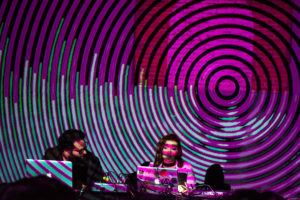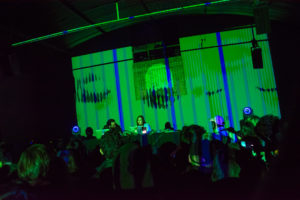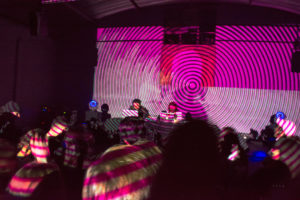The second in a series of interviews with TidalCycles people, this one with the awesome Malitzin Cortes, who is based in Mexico City and performs music as CNDSD, including with SuperCollider and Tidal. Follow her on Twitter and Facebook, and be sure to check out her work on soundcloud, tumblr and vimeo. You can also read a pro interview with her en Español in Noisey.
Hi Malitzin, are there particular ‘strategies’ you have developed/collected for
using Tidal? e.g. combinations of functions you like to use together,
particular ways you like to twist patterns etc. Feel free to share
particular examples!
Personally, my knowledge about Tidal has grown, studying the guide on the website and experimenting with these codes, as well with tutorials, testing with my own sounds to the extreme, sometimes simple sounds work best to test and understand how some functions affect the sound.
An extremely seductive quality of the tides is the way of writing, in which I find the logic and emotion of the sequence that I am beginning to compose.
It seems to me extremely poetic, we can write with grammatical sense and algorithmic sense at the same time, some converters like superimposition or palindrome, to mention two, that, combined with iterations can create deep and complex sonorous experiences.
--- Example ** bps (180/120) d1 $ slowspread ($) [rev, (|+| accelerate "-2 4 12"), (|+| coarse "12 24 6"), chop 20, stut 4 0.05 0.25] $ foldEvery [2,4,6] (10.5 <~) $ slowcat [ sound (samples "supernoise*4"(irand 8)), sound (samples "supergong*8"(irand 20)), sound (samples "superchip*4"(irand 2)), sound (samples "supersnare*4"(irand 40))] |+| unit "c" |+| speed "4" #gain "[[1.7 0.5]/2 [0.5 1.8]]*2 " |=| pan "0.05 0.75" #delay "0.5" # delaytime "0.04" # decay "0.1" # sustain "0.15" # room "2" d2 $ palindrome $ superimpose ((# speed "8") . (2 <~)) $ sound (samples "[bassfoo*2 casio*8]/2" (irand 10)) |+| unit "c" |+| speed "1" #gain "[[1.5 0.4]*2 [0.5 1.9]]*2 " |=| pan "-2 1 1 0.55" # n (toScale [1, 5, 7] " 1 3 3 -4")

Or to phrase that question another way, what parts of tidal do you
feel drawn to most? Has this changed over time, are their
techniques/functions you explore in depth but then grow bored with?
In the beginning some options lead me to a rhythm more quickly and predictably, but then I found complexity in these same functions through combination with others, leaving the common rhythm behind.
Playing with different sound parameters, the tempo of a sequence of patterns can be extended and become a mass of sound that doesn’t seem to have an identity as a rhythmic pattern, although in the background it is still there!
On the contrary it is difficult for me to get bored, for the moment I don’t think I have reached 5% of the potential of Tidal, I’m always testing functions and combinations and when I do not write well (due to a bad syntax) I learn, and discover that the correct syntax generates new effects and behaviors depending on the number of samples or synthdefs used.
To what extent do you use the standard dirt samples? If you use your
own samples as well do you feel this is important in some way?
I think that as in every library of whatever : images, cats or sounds, there are some more beautiful and interesting that you can not just discard. The default library was the first door to understanding how Tidal worked and what potential it has since you start with the first pattern and by continuing to use it, you discover and understand (especially if you are not a programmer) how a function transforms the sound.
I began to get ideas and the frantic desire to experiment with other sounds.
Personally I keep sounds extremely clean and forceful of this default library and I have dedicated to create one, which is the identity of what I compose and of my music: recorded sounds, voice samples, midi and endless synthdefs.
How do you see the tidal community/communities in relation to the
tidal language?
The community is extremely important in the process of learning and understanding the use of Tidal, as well as in the personal search for a sound identity and to know the work of other people who use it.
Some extremely committed and brilliant people in technical matters (Mike Hodnick) have really supported me in solving doubts and understanding Tidal better, also you learn a lot from the questions of others and from all the deductions that can come out when answering these questions.
Sharing music from different parts of the world makes you understand the sound and music panorama more deeply, how these artists use the same functions to create completely different realities and sound personalities.
 How does Tidal compare to other music-making activities/software you have engaged with?
How does Tidal compare to other music-making activities/software you have engaged with?
Contrary to what you might think, for me Tidal is extremely friendly and when you go deeper, it becomes more abstract and free than other softwares that I really love and use to compose and generate sounds.
Now Tidal has become a place where I can experiment, improvise live and also compose, the latter perhaps in a not so orderly way, not because it’s not possible, but because it’s so free that you create your own rules.
How approachable do you find the Tidal community/communities, do you think there is a language/cultural barrier and/or do you think there are separate communities growing around Spanish language and/or locality in Mexico/America?
If your knowledge of programming and English is poor, at first it can be very confusing, this is my case, but the same programming has made me want to acquire a higher level of English in order to understand Tidal better.
I think that with the existence of translate tools the barriers are becoming smaller when there is an intrinsic interest, I would like in the near future to be able to translate and give workshops in which Tidal can be understood in Spanish very clearly if the level of English of the people concerned actually represents a barrier to delve into it.
There are people in Mexico and Colombia developing their own live coding languages and in general are very willing to share their knowledge and experience, in SuperCollider mostly.
 How does Tidal influence your work, when you are using it do you feel like you are composing, improvising, exploring?
How does Tidal influence your work, when you are using it do you feel like you are composing, improvising, exploring?
I think all three, in my process the experimentation begins in the pursuit of understanding, also trying to find how I want to sound.
After mixing sounds and beginning to compose patterns improvisation is extremely easy and natural in Tidal, when you begin to listen and you propose to direct the sounds and rhythmic complexities or textures is where the composition process begins.
What do you think Tidal is?
For me it is the music of the future, not only in Tidal, it’s algorithmic music itself, but without doubt Tidal has achieved many things in terms of simplification thanks to functional programming, allowing it to go far when it comes to live coding and improvisation in a few lines.
I would like Tidal have more things, but I know that it is the beginning of something tremendous, that allows us to take sound to places uncommon and to transgress the motricity in the music. It’s that search of sounds that seem impossible and are only possible in the computer, Tidal allows you to find an unimaginable panorama of combinations.
I think I have explored little and I always want to know more and especially ask myself questions about whether it is possible that what’s in my mind musically can translate into a reality .
and always surprises me and leads me to take all sorts of decisions.
Thanks Malitzin!

One thought on “Interview with Malitzin Cortes a.k.a. CNDSD”